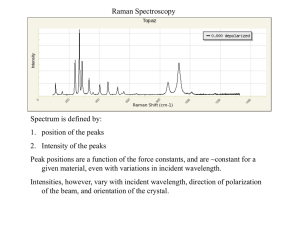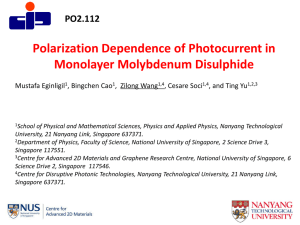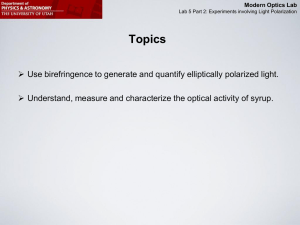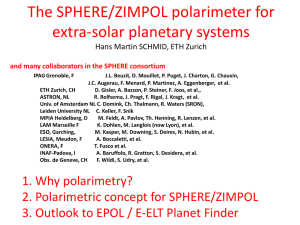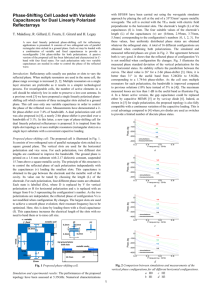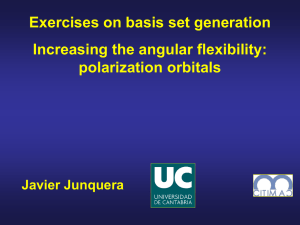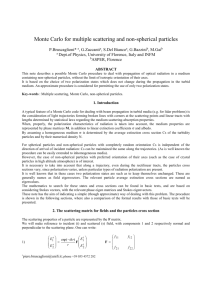Linear and circular radio and optical polarization
advertisement
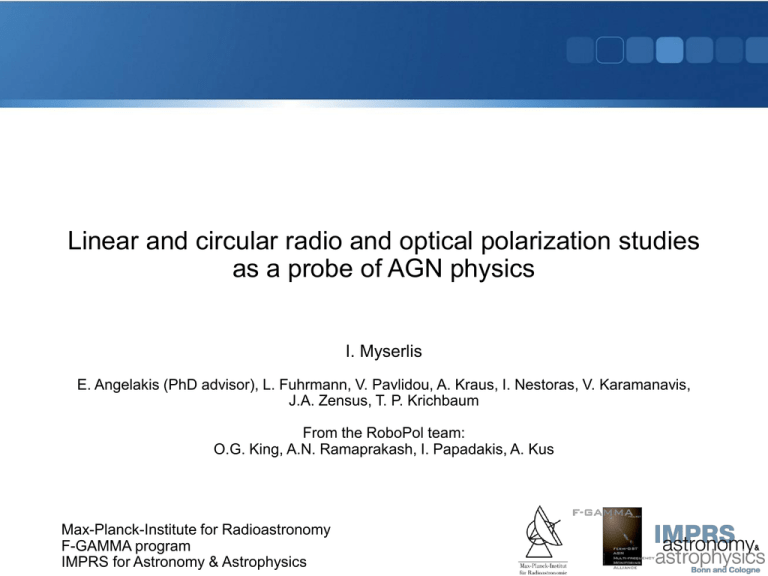
Linear and circular radio and optical polarization studies as a probe of AGN physics I. Myserlis E. Angelakis (PhD advisor), L. Fuhrmann, V. Pavlidou, A. Kraus, I. Nestoras, V. Karamanavis, J.A. Zensus, T. P. Krichbaum From the RoboPol team: O.G. King, A.N. Ramaprakash, I. Papadakis, A. Kus Max-Planck-Institute for Radioastronomy F-GAMMA program IMPRS for Astronomy & Astrophysics Outline • Idea • Facts Radio polarization and AGN • Theory • Practice The RoboPol Program • Introduction • Current work Fletcher et al., 2011, MNRAS, 412, 2396 The F-GAMMA Program The F-GAMMA Collaboration Multi-frequency monthly monitoring of 60 γ-ray blazars • Flux density variability • Spectral evolution • Polarization variability Main facilities • 100-m Effelsberg telescope (Germany): 2.64, 4.85, 8.35, 10.45, 14.60, 23.05, 32.00, 42.90 GHz • 30-m Pico Veleta IRAM (Spain): 86.24, 142.33, 228.39 GHz • 12-m APEX (Chile): 345 GHz fermi.gsfc.nasa.gov MPIfR MPIfR Data products Blazar 3C454.3 Light curves Spectra Data: F-GAMMA Program Scientific objectives Stand-alone radio studies: • Radio variability mechanism (e.g. unification of variability patterns, Angelakis et al., in prep.) • Spectral evolution of flaring events (Angelakis et al., in prep.) • Variability and time series analysis of radio datasets (Nestoras et al., in prep.; Angelakis et al., in prep.) • Test shock models (e.g. cross-frequency time lags) • … Multi-band studies: • Radio vs γ-ray flux correlation (biases-free methodology Pavlidou et al., 2012; Fuhrmann et al, in prep.) • Cross-band correlation analysis (Fuhrmann et al., in prep.) • Location of the γ-ray emitting region (Fuhrmann et al., in prep.) • γ-ray loudness and radio variability (Fuhrmann et al., in prep.; Richards et al., 2012) • Optical polarization angle swings during high energy events (see part 3) • … Radio polarization and AGN Incoherent synchrotron emission → polarized emission Polarization measurements • • Linear polarization • Polarization angle → Magnetic field orientation • Polarization angle + Faraday rotation → Integrated magnetic field magnitude Circular polarization • Faraday conversion → Jet composition (e.g. Beckert & Falcke, 2002) Polarization monitoring • Dynamics of the physical properties • Test of variability models • Correlation with: Total flux density, spectral index, spectral evolution, structural evolution, optical polarization • Investigate polarization angle swings during high-energy flares Radio polarization data reduction AGN have low levels of polarization Instrumental polarization (e.g. ~1% at 5 GHz) Müller matrix: Transfer function between the real and observed Stokes parameters 𝑺𝒐𝒃𝒔 = 𝑴 ∙ 𝑺𝒓𝒆𝒂𝒍 → 𝑺𝒓𝒆𝒂𝒍 = 𝑴−𝟏 ∙ 𝑺𝒐𝒃𝒔 𝐼𝑜𝑏𝑠 𝑄𝑜𝑏𝑠 𝑈𝑜𝑏𝑠 𝑉𝑜𝑏𝑠 = 𝑚11 𝑚21 𝑚31 𝑚41 𝑚12 𝑚22 𝑚32 𝑚42 𝑚13 𝑚23 𝑚33 𝑚43 𝑚14 𝑚24 𝑚34 𝑚44 𝐼𝑟𝑒𝑎𝑙 𝑄𝑟𝑒𝑎𝑙 ∙ 𝑈𝑟𝑒𝑎𝑙 𝑉𝑟𝑒𝑎𝑙 [1] Homan et al., 2009, ApJ, 696, 328 Method 1. Observe sources with known polarization characteristics 2. Solve the system of equations [1] by fitting our measurements 3. Apply the instrumental polarization correction to our target sources Radio polarization data reduction An example at 4.85 GHz: • Stable calibrators • High CP degrees for some sources, cross-checked with other stations (UMRAO) LP (%) Source 3C286 CP (%) Note Before After Archival Before After Archival Calibrator 10.55 10.81 11.00 -0.33 0.01 0.00 3.79 4.77 4.20 -0.06 0.34 0.00 0.41 0.42 0.00 -0.68 -0.54 -0.60 2.34 2.75 - -0.92 -0.83 - 5.14 6.13 - -0.85 -0.90 - Calibrator 3C48 Calibrator 3C84 3C454.3 Target Target JUPITER Current work: • Stabilize data reduction pipeline • Extend to other frequencies • Produce radio polarization light curves Optical polarization swing events • 3C279: Abdo et al., 2010, Nature, 463, 919 • PKS 1510-089: Marscher et al., 2010, ApJ, 710, 126 • BL Lacertae: Marscher et al., 2008, Nature, 452, 966 Possible interpretation (Marscher et al., 2008): Emission feature moving along a streamline in the acceleration and collimation zone Marscher et al., 2008, Nature, 452, 966 Abdo et al., 2010, Nature, 463, 919 Rarely it has been observed during γ-ray outbursts The RoboPol Program Chasing optical polarization swing events Optical polarimeter on Skinakas telescope (UoC) Instrument: A. N. Ramaprakash (IUCAA), specifically for the telescope Fully automated, on-the-spot data reduction : O. G. King (Caltech) Observing strategy Observe massively: 50 – 100 sources • Observe frequently: 2 to 3–night cycles • Observe dynamically: Dynamic observing schedule by real-time data reduction Smith et al., 2009 • Image: E. Angelakis Candidate target sample Fermi detectable Flux limited sub-sample of 2FGL catalogue → 557 sources γ-ray variable 1% or less to be non-variable in γ-rays (variability index ≥ 41.64) Optically detectable from Skinakas Archival optical magnitude ≤ 18 mag Other constrains Observable for 3 consecutive months Airmass ≤ 2 e.g. June 86 sources Moon avoidance Current status Sub-sample (80) observed in June 2012 • Up-to-date photometry • Test data reduction pipeline Continue photometric observations (October 2012) Get information on optical polarization Polarimetric observations with IUCAA Girawali Observatory (December 2012) Control sample observations (October 2012) Are there any differences in the optical characteristics of sources which are expected to be Fermi detectable from radio observations? Small source sample (10) to investigate • Radio variable • Fermi non-detected


